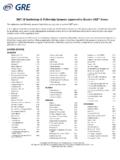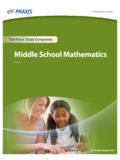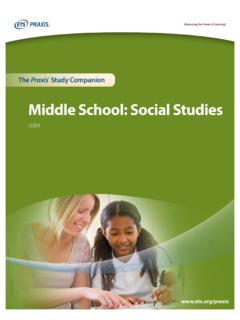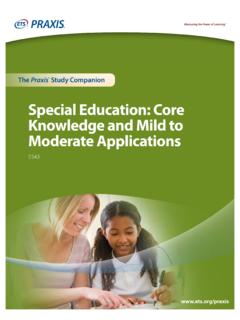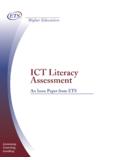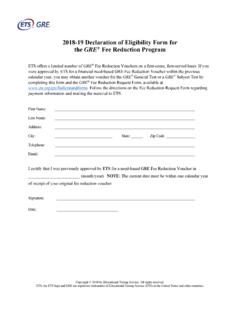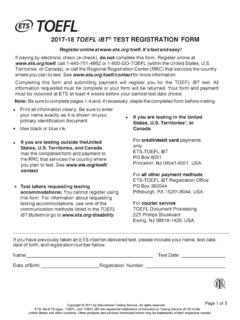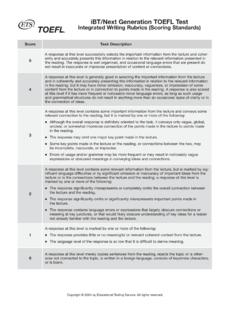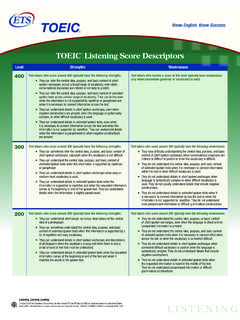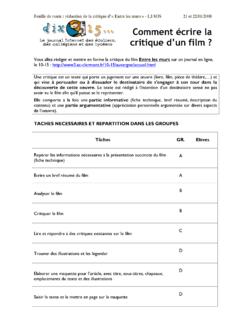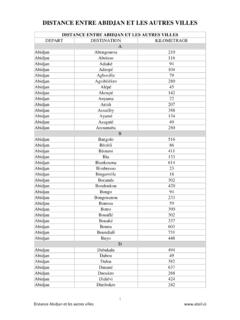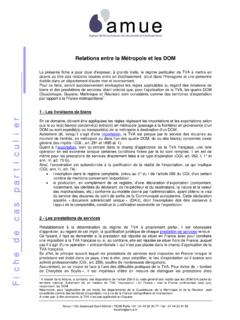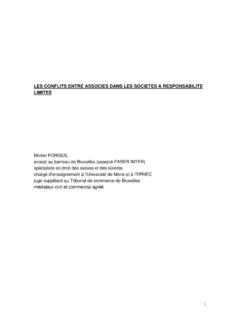Transcription of A Guide to Understanding TOEFL iBT® Score - ETS …
1 A Guide TO Understanding TOEFL IBT SCORESHIGH (22 30)INTERMEDIATE (15 21)LOW (0 14)YOUR PERFORMANCETest takers who receive a Score at the HIGH level typically understand academic texts in English that require a wide range of reading abilities regardless of the difficulty of the takers who Score at the HIGH level typically: have a very good command of academic vocabulary and grammatical structure can understand and connect information, make appropriate inferences and synthesize ideas, even when the text is conceptually dense and the language is complex can recognize the expository organization of a text and the role that specific information serves within the larger text, even when the text is conceptually dense can abstract major ideas from a text, even when the text is conceptually dense and contains complex languageTest takers who receive a Score at the INTERMEDIATE level typically understand academic texts in English that require a wide range of reading abilities, although their Understanding of certain parts of the texts is takers who receive a Score at the INTERMEDIATE level typically.
2 Have a good command of common academic vocabulary, but still have some difficulty with high-level vocabulary have a very good Understanding of grammatical structure can understand and connect information, make appropriate inferences, and synthesize information in a range of texts, but have more difficulty when the vocabulary is high level and the text is conceptually dense can recognize the expository organization of a text and the role that specific information serves within a larger text, but have some difficulty when these are not explicit or easy to infer from the text can abstract major ideas from a text, but have more difficulty doing so when the text is conceptually denseTest takers who receive a Score at the LOW level typically understand some of the information presented in academic texts in English that require a wide range of reading abilities, but their Understanding is takers who receive a Score at the LOW level typically.
3 Have a command of basic academic vocabulary, but their Understanding of less common vocabulary is inconsistent have limited ability to understand and connect information, have difficulty recognizing paraphrases of text information, and often rely on particular words and phrases rather than a complete Understanding of the text have difficulty identifying the author s purpose, except when that purpose is explicitly stated in the text or easy to infer from the text can sometimes recognize major ideas from a text when the information is clearly presented, memorable or illustrated by examples, but have difficulty doing so when the text is more demandingADVICE FOR IMPROVEMENTRead as much and as often as possible. Make sure to include academic texts on a variety of topics written in different genres and with different degrees of conceptual density as part of your reading.
4 Read major newspapers, such as The New York Times or Science Times, and websites (National Public Radio [NPR] or the BBC). Write summaries of texts, making sure they incorporate the organizational pattern of the originals. Continually expand your vocabulary. Continually practice using new words you encounter in your reading. This will help you remember both the meaning and correct usage of the new as much and as often as possible. Study the organization of academic texts and overall structure of reading passages. Read an entire passage from beginning to end. Pay attention to the relationship between the main ideas and the supporting details. Outline the text to test your Understanding of the structure of the reading passage. Write a summary of the entire passage. If the text is a comparison, be sure that your summary reflects that.
5 If the text argues two points of view, be sure both points of view are reflected in your expand your vocabulary by developing a system for recording unfamiliar words. Group words according to topic or meaning and study the words as a list of related words. Study roots, prefixes and suffixes; study word families. Use available vocabulary resources, such as a good thesaurus or a dictionary of collocations (words commonly used together).Read as much and as often as a system for recording unfamiliar words. Group words into lists according to topic or meaning and review and study the words on a regular basis so that you remember them. Increase your vocabulary by analyzing word parts; study roots, prefixes and suffixes; study word the organization of academic texts and overall structure of a reading passage.
6 Read an entire passage from beginning to end. Look at connections between sentences; look at how the end of one sentence relates to the beginning of the next sentence. Look for the main ideas and supporting details and pay attention to the relationship between them. Outline a text to test your Understanding of the structure of a reading passage. Begin by grouping paragraphs that address the same concept. Write one sentence summarizing the paragraphs that discuss the same idea. Write a summary of the entire : Performance descriptions appear on test-taker Score reports and not on institutional Score reports. These descriptions may be refined with additional research. The advice listed here is only a sample of the advice available. A Guide TO Understanding TOEFL iBT SCORES32 READING SKILLSLEVELNote: Performance descriptions appear on test-taker Score reports and not on institutional Score reports.
7 These descriptions may be refined with additional research. The advice listed here is only a sample of the advice available. A Guide TO Understanding TOEFL iBT SCORES54 LISTENING SKILLSHIGH (22 30)INTERMEDIATE (15 21)LOW (0 14)YOUR PERFORMANCETest takers who receive a Score at the HIGH level typically understand conversations and lectures in English that present a wide range of listening demands. These demands can include difficult vocabulary (uncommon terms, or colloquial or figurative language), complex grammatical structures, abstract or complex ideas, and/or making sense of unexpected or seemingly contradictory listening to lectures and conversations like these, test takers at the HIGH level typically can: understand main ideas and important details, whether they are stated or implied distinguish more important ideas from less important ones understand how information is being used (for example, to provide evidence for a claim or describe a step in a complex process) recognize how pieces of information are connected (for example, in a cause-and-effect relationship) understand many different ways that speakers use language for purposes other than to give information (for example, to emphasize a point, express agreement or disagreement, or convey intentions indirectly)
8 Synthesize information, even when it is not presented in sequence, and make correct inferences on the basis of that informationTest takers who receive a Score at the INTERMEDIATE level typically understand conversations and lectures in English that present a wide range of listening demands. These demands can include difficult vocabulary (uncommon terms, or colloquial or figurative language), complex grammatical structures and/or abstract or complex ideas. However, lectures and conversations that require the listener to make sense of unexpected or seemingly contradictory information may present some listening to conversations and lectures like these, test takers at the INTERMEDIATE level typically can: understand explicitly stated main ideas and important details, especially if they are reinforced, but may have difficulty Understanding main ideas that must be inferred or important details that are not reinforced understand how information is being used (for example, to provide support or describe a step in a complex process) recognize how pieces of information are connected (for example, in a cause-and-effect relationship) understand, though perhaps not consistently, ways that speakers use language for purposes other than to give information (for example, to emphasize a point, express agreement or disagreement, or convey intentions indirectly)
9 Synthesize information from adjacent parts of a lecture or conversation and make correct inferences on the basis of that information, but may have difficulty synthesizing information from separate parts of a lecture or conversationTest takers who receive a Score at the LOW level typically understand the main idea and some important details of conversations. However, test takers at the low level may have difficulty Understanding lectures and conversations in English that involve abstract or complex ideas and recognizing the relationship between those ideas. Test takers at this level also may not understand sections of lectures and conversations that contain difficult vocabulary or complex grammatical takers at the LOW level typically can: understand main ideas when they are stated explicitly or marked as important, but may have difficulty Understanding main ideas if they are not stated explicitly understand important details when they are stated explicitly or marked as important, but may have difficulty Understanding details if they are not repeated or clearly marked as important, or if they are conveyed over several exchanges among different speakers understand ways that speakers use language to emphasize a point or to indicate agreement or disagreement, but generally only when the information is related to a central theme or is clearly marked as important make connections between the key ideas in a conversation.
10 Particularly if the ideas are related to a central theme or are repeatedADVICE FOR IMPROVEMENTF urther develop your listening ability with daily practice in listening in English and by challenging yourself with increasingly lengthy listening selections and more complex listening material. Listen to different kinds of materials on a variety of topics: Focus on topics that are new to you. Listen to academic lectures and public talks. Listen to audio and video material on TV, radio and the Internet. Listen to programs with academic content, such as NOVA , BBC and NPR broadcasts. Listen to conversations, phone calls and phone recordings. Take live and audio-recorded tours ( , of museums). Listen actively: Take notes as you listen for main ideas and important details. Make predictions about what you will hear next.
